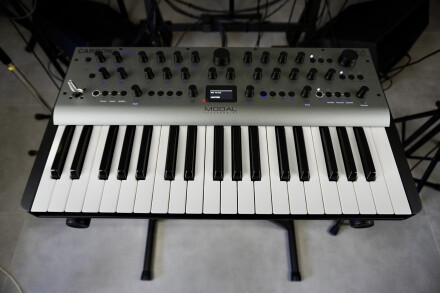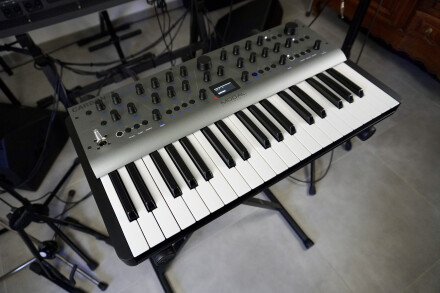After the wavetable-based Argon8 and the analog-modeling-based Cobalt8, Modal presents the Carbon8, featuring oscillators with modulable high-resolution algorithms. Let's see how it stands out...

The Carbon8 was first presented at Superbooth 2023, at a time when British firm Modal Electronics was experiencing financial difficulties. The synth’s release was therefore postponed, and it was only at the end of 2024, after the brand (and a reduced team) had been taken over by WT Technology Development Limited (Hong Kong), that the first Carbon8 models made a timid appearance on the market. In the meantime, French distribution has been taken over by Adagio France. They have just sent us a brand-new Carbon8 for the occasion. This is the model with the 3-octave keyboard. The module version, called Carbon8M, has been announced, but we don’t know at this stage whether a 5-octave keyboard 8X version will see the light of day. The Carbon8 series thus succeeds the Argon (2020 – wavetable synthesis) and Cobalt (2022 – extended analog modeling synthesis) series. We tested the machine in firmware version 1.1.
Copy Carbon: a familiar design, but power reviewed-upward
The Carbon8 uses the same chassis and physical controls as its predecessors. Only the functions linked to the heart of the sound engine (oscillators, filter, LFO in particular) change. The synth is packaged in the same slim cardboard box but seems to be well cushioned by two side pieces and a high-density foam protection under the keys. In addition to the synth, Modal provides us with a rather cheap external 9V/1.5A/center+ power supply, a USB A-B cable and a simple A4 sheet of cardboard as a quick-start guide (a not-very detailed instruction manual can be downloaded from the Modal Electronics website). The synth weighs 5.6 kg (12.4 lbs) and measures 55.5 × 30 × 10 cm (21.85 × 11.81 × 3.94 inches). Rather heavy for its compact size, it’s built like a tank, with its thick anodized aluminum front panel, metal shell painted with a clearly legible gray background silkscreen and thick black-stained wood sides.

The brightness of the display and LEDs can be adjusted in the System menu. On these points, we’re up to the same quality standards as the Argon/Cobalt series. The 29 encoders (27 smooth, ventilated on the front panel and two notched on either side of the screen) seem to be of better quality than on previous models. To the best of our recollection, the resistance is correct, the axis seems firm, and only the caps have some play. As for the material, the plastic seems less unpleasant to the touch than on previous models.
An intuitive interface with complete controls
The module organization is identical in every respect to that of the Argon/Cobalt: LFO, oscillators, filter, effects, volume, envelopes, joystick, vintage mode, transposition (-3/+4 octaves and –12/+24 semitones), keyboard modes, central editing, arpeggiator and sequencer. However, it’s a little easier to find your way around visually, thanks to the silkscreen delineating the various modules. You’ll have to look hard to spot the few differences with its predecessors (oscillators, filters and LFOs in particular). The Init and Random (random sound creation) buttons are present, but the Compare function is still nowhere to be found. There’s only a notched encoder-pusher to navigate through 500 programs (by scrolling or by bank of 100 programs), with no categorization. Memories loop between numbers 500 and 1, so much the better. To navigate the menus, a second encoder is used to select pages and choose the parameter to be edited as soon as it is pressed.

Connections, which are identical to those on Argon/Cobalt, are grouped together on the rear panel. The card, which is not screwed in, tends to move a little. There are no surprises or omissions among the available sockets: in 6.35 (1/4") jack format, a stereo headphone output, two left (mono) / right TS line outputs, and two pedal inputs (switch and continuous). In mini-jack format, one stereo audio input (routing to effects, but not to filter), one sync input and one sync output. On the digital side, a MIDI DIN pair (input + output switchable to Thru) and a USB-B socket (MIDI only, still no audio). Near the mains switch is the terminal for the external power supply already mentioned.
.
Digitally yours – the digital architecture
The Carbon8 is an 8-voice polyphonic monotimbral digital synth. Its 500 user memories include 300 factory-preprogrammed sounds, which are well thought-out. They allow you to see what the synth has up its sleeve while also being useful, directly or as a starting point for personal creations. The Carbon8 is geared towards evolving digital textures, even if a few classics of subtractive synthesis can be found here and there (we prefer a pure analog in this register, of which it will be a perfect complement). We were won over by the audio quality and sound of the Carbon8, which convinced us more than its predecessors from the very first listen. Already, output levels are high, differentiating it from the first Argon/Cobalt versions we tested, without pushing the programmable gain excessively in addition to the volume. There’s no noticeable background noise, and the audio engine has been given particular attention by the developers.

The Carbon8 has a sonic identity all its own, with presence at both ends of the spectrum. At the top, it can produce crystal-clear sounds with very controlled highs, rising very high without flinching (unless you push the oscillators too far, especially with the integrated Wave-Folders / Wave-Shapers). Down low, the bass is powerful, and the infra bass will make those for whom a serious bowl starts at 38 cm salivate. It can also produce low-resolution sounds with metallic bass reminiscent of early digital synths or vintage hybrids, PPG, Prophet-VS — a compliment!
Attacks can be straightforward, envelopes ultra-fast (several curves are available, from lively percussion to endless strings). Some ultra-resonant filters literally slice up the sound, others create guttural textures (reminiscent of the Twin Peaks filter), while others provide heavy saturation. The effects are flattering, with combinations of stereo delay + chorus + reverb bringing dimension to layers or percussive sounds. There’s a new, full-bodied stereo chorus that sounds like it came straight off a Juno-60 and a new reverb with very pleasant “Shimmering colors.” In short, an excellent aural surprise, all the more so as it’s possible to quickly switch between different sound colors with a few decisive parameters, including the continuous transformation of oscillators and certain filter types.
.

- Carbon8_1audio 01 SVF Arp01:23
- Carbon8_1audio 02 Digital Ambiance01:19
- Carbon8_1audio 03 Huge Sync00:48
- Carbon8_1audio 04 Delayed Saws00:57
- Carbon8_1audio 05 Evolving Bass01:12
- Carbon8_1audio 06 Terminus Day00:38
- Carbon8_1audio 07 Vocal Art00:46
- Carbon8_1audio 08 Heart of Asia00:34
- Carbon8_1audio 09 Vintage Vibe00:40
- Carbon8_1audio 10 Arp Endings01:10
High-resolution
The Carbon8 is presented as a synth with oscillators twice as complex as its predecessors. But what are they? Each voice consists of two oscillators, a filter, three LFOs, three envelopes and a modulation matrix. Each oscillator calls on one of the 56 wave algorithms supplied, which can be modulated continuously with the “Contour” parameter. This crucial parameter, the destination of the modulation matrix, varies according to the type of algorithm selected and is indicated on the screen as soon as it is modified. The same screen also displays the waveform obtained in real-time. The 56 algorithms include classic internally-synchronized waves, waves passed through a Wave-Folder, PWM, phase-modulated waves, phase-distorted waves, resolution-reduced waves, resonant waves and audio-modulated noise. Oscillators can be freely cycled or triggered on each note.
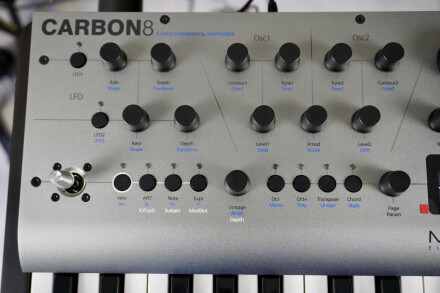
Filters revisited
The Argon8 was equipped with four models of 2-pole SEM-type filters, while the Cobalt8 featured four models of 4-pole ladder filters with continuous state variables. Since the latest firmware releases, Modal has improved matters, with both models now incorporating 8 and 31 filter types. The Carbon8 pushes the envelope even further, with 34 filter types, some dual with morphing, others static with saturation, including some of its predecessors. We start with two types of state-variable 2-pole filters, enabling progressive switching between LP/BP/HP and LP/Notch/HP. Next come seven types of dual 2-pole filters with continuous morphing: LP (x2), BP, HP (x2), Notch (two resonant peaks) and Phaser (ladder). Finally, there are 25 types of static 1–2–3–4-pole ladder filters with variable saturation, available in different LP/BP/HP/Notch modes. In short, an even more muscular section than the Carbon8's predecessors.

The filter’s cutoff frequency can be set directly with a large, smooth encoder, along with resonance and continuous morphing/saturation (“Warp” parameter). The display shows the filter profile in real-time, which is very useful. Bipolar modulation of the filter envelope has its own encoder. Frequency response is perfectly smooth, so much the better. Keyboard tracking can also be set to different responses and dosed via the modulation matrix.
The different types of filters are truly complementary and add value to the sound palette. At the filter output, you can adjust the volume (and gain via the menu) and modulate it with a dedicated envelope. There’s no panning adjustment, only a stereo widening parameter, alternating voices, which unfortunately cannot be modulated. There are also various voice modes: poly, mono, unison (2-, 4-, or 8-voice, useful for weighing down basses), stacking (2– or 4-voice), chord and inverted chord (adding one or two octaves to one of the notes of a chord).
Serious modulations
Like its predecessors, the Carbon8 offers excellent modulation possibilities. To start with, there’s a variable-speed polyphonic portamento, which can be triggered permanently or only on the notes linked. Then there are three LFOs (global LFO1, polyphonic LFO2 and LFO3) with 15 continuously modifiable waveforms (from sine, triangle, square, ramp, sawtooth, S&H, smoothed S&H, combinations). The modification is a destination of the modulation matrix — great! The resulting waveform is displayed graphically.
Oscillation can be free-running, retriggered at each note or played on a single cycle. LFO speed can be adjusted by hand (right down to the audio frequencies when following the keyboard) or synchronized to tempo according to different divisions. There is no delay or fade, however. To assign an LFO to a synthesis parameter (and effects parameter for LFO1), switch on the LFO knob and turn the destination encoder; the amount of modulation, bipolar, is set via the destination encoder or data potentiometer. Then there are three ADSR envelopes: two assigned to filter and volume, the third assignable via the modulation matrix. The modulation quantities of the filter and assignable envelopes are bipolar. There are also 8 types of envelope response (curves), ranging from very dry percussive sounds to long, evolving pads.
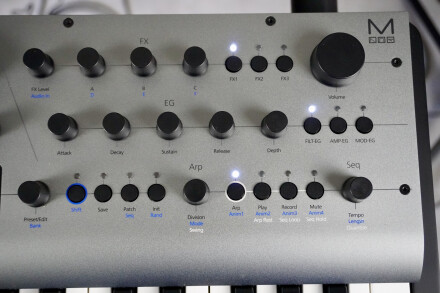
Destinations include each oscillator’s contour/pitch/volume, filter cutoff/resonance/variation, portamento, each LFO’s depth/velocity/waveform/variation, each envelope’s segments/amount, all effects parameters and global pitch. Not all source/destination combinations are possible, especially polyphonic sources to mono destinations, which seems normal. In addition to the eight assignable modulation cords, there are four pre-assigned cords with bipolar modulation: keyboard tracking on filter cutoff, joystick up (+Y) assigned to LFO1 amount, pressure on filter cutoff and velocity on volume envelope. The only thing missing is pan modulation, as we’ve already pointed out.
Refreshed effects
At the output of the amplifier stage, the sound passes through three stereo multieffects, with only one instance per program. They are placed in series and reversible. An external audio signal can be routed to the effects (or directly to the stereo output). Each multieffect is capable of producing 26 algorithms, which more or less correspond to the developments seen in the Argon/Cobalt firmware: chorus, phaser, positive flanger, negative flanger, tremolo, unison, fidelity reducer, rotary speaker, stereo delay, ping-pong delay, cross delay, reverb, compressor, mono saturation and stereo saturation.

Six parameters are available per effect, accessed with 3 encoders and the Shift key. Delay times can be clock-synchronized in different time divisions. This allows them to be run in sync with LFOs, arpeggios and sequences. To assist the user, the Carbon8 comes with 100 rewritable effects presets. The quality of the effects varies according to the algorithm: impeccable delays, phaser and flanger, but rotary, chorus and basic reverb are not so great. Fortunately, the new Chorus 2 and Reverb 2 are quite good. Reverb 2, like stereo saturation, consumes two multieffect slots. Without hesitation, we sacrificed a slot — when we wanted a long reverb — by opting for this new algorithm.
A powerful arpeggiator and sequencer, but perfectible
The Carbon8 features a small arpeggiator similar to that of its predecessors. It is activated by pressing the key of the same name. Hold it down to record notes and rests, using the keyboard (or via MIDI), up to a maximum of 32 steps. Next, select the time division, then the playback mode (15 patterns transposable from one to four octaves, with pendulum, shuffle, aleator and chord modes), swing (bipolar, i.e., with note advance or delay) and note duration (gate). A mode allows arpeggios to be held when keys are released, with the option of holding (via a key combination). Of course, the notes entered are not saved in the programs; only the parameters described above are nothing shocking.
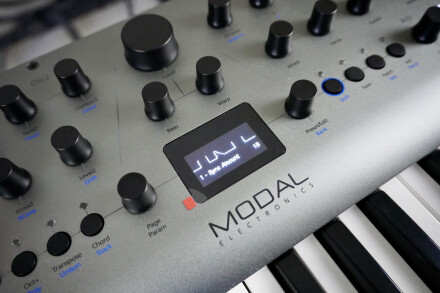
During playback, you can change loop points or loop on a single step on the fly. You can also transpose the sequence by holding down the appropriate button and playing the keyboard. There are 100 memories, and each program can store a link to a sequence number. These memories are preloaded from the factory. Note that arpeggiated and sequenced notes can be transmitted via MIDI. We really wish Modal had improved the memory management of its sequencer’s two modes, as it’s not uncommon to want to add step-by-step notes after programming a sequence in real-time. One gets the feeling that R&D’s efforts have been put elsewhere.



